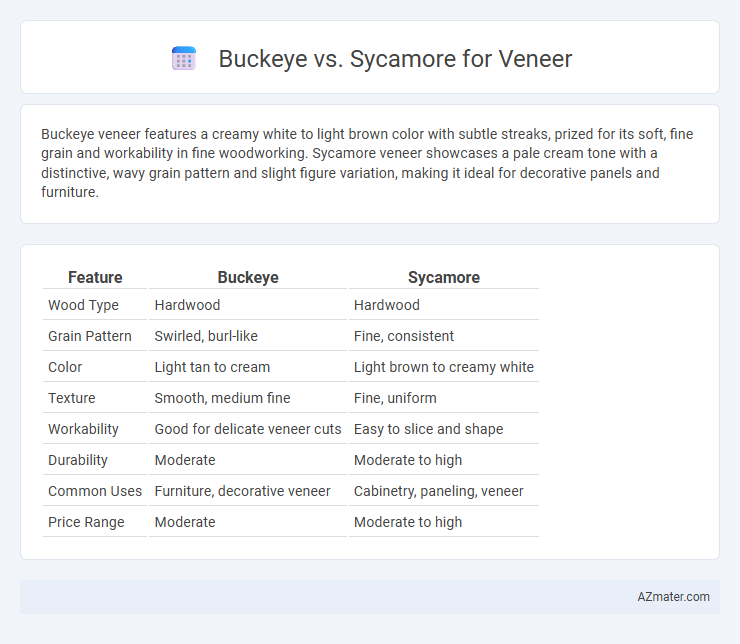Buckeye veneer features a creamy white to light brown color with subtle streaks, prized for its soft, fine grain and workability in fine woodworking. Sycamore veneer showcases a pale cream tone with a distinctive, wavy grain pattern and slight figure variation, making it ideal for decorative panels and furniture.
Table of Comparison
| Feature | Buckeye | Sycamore |
|---|---|---|
| Wood Type | Hardwood | Hardwood |
| Grain Pattern | Swirled, burl-like | Fine, consistent |
| Color | Light tan to cream | Light brown to creamy white |
| Texture | Smooth, medium fine | Fine, uniform |
| Workability | Good for delicate veneer cuts | Easy to slice and shape |
| Durability | Moderate | Moderate to high |
| Common Uses | Furniture, decorative veneer | Cabinetry, paneling, veneer |
| Price Range | Moderate | Moderate to high |
Introduction to Buckeye and Sycamore Veneer
Buckeye veneer offers a distinctive appearance with its creamy, pale background highlighted by striking black or dark brown streaks, making it popular for decorative woodworking and custom furniture. Sycamore veneer features a smoother, more consistent grain pattern with subtle color variations ranging from creamy white to light brown, prized for its elegance and versatility in cabinetry and paneling. Both veneers originate from hardwood trees native to North America and provide durable, visually appealing surfaces that enhance interior design projects.
Botanical Origins and Characteristics
Buckeye veneer originates from the Aesculus genus, primarily Aesculus glabra, and is known for its pale, creamy color with occasional dark specks resembling buckeyes. Sycamore veneer, derived from Platanus occidentalis, features a lighter, almost white base with a distinctive, wavy grain pattern and a smooth texture. Both woods exhibit moderate hardness, but Buckeye is prized for its unique speckling and uniformity, while Sycamore stands out for its bright appearance and striking figuring in veneer applications.
Visual Appearance and Grain Patterns
Buckeye veneer features a creamy beige to light brown background with contrasting reddish-brown streaks and swirling grain patterns, creating a bold and dynamic visual appeal. Sycamore veneer displays a more uniform light tan to pale yellow color with subtle, flowing grain patterns that tend to be straighter and less pronounced than Buckeye. The distinctive swirling grains of Buckeye add dramatic character to furniture or paneling, while Sycamore offers a softer, more consistent look ideal for elegant, understated designs.
Durability and Workability
Buckeye veneer offers moderate durability with a soft texture that makes it highly workable for detailed carving and fine finishes, ideal for decorative applications. Sycamore veneer provides greater durability due to its tighter grain and hardness, making it more resistant to wear while maintaining good machinability for cabinetry and furniture surfaces. Both veneers exhibit distinct workability characteristics, with Buckeye favored for intricate designs and Sycamore preferred for robust, long-lasting projects.
Color Variations and Finishing Options
Buckeye veneer exhibits a unique range of color variations from creamy white to light brown with occasional pink and reddish streaks, while Sycamore veneer typically displays a consistent pale cream to light tan hue with subtle figuring. Buckeye's irregular grain and richer color palette create eye-catching patterns, making it ideal for decorative finishing techniques such as staining and hand-rubbed oils. Sycamore's smooth texture and uniform coloration respond well to clear finishes like lacquer or polyurethane, highlighting its natural brightness and fine detailing.
Popular Applications in Woodworking
Buckeye veneer is prized in woodworking for its striking, swirling grain patterns and creamy coloration, making it ideal for decorative panels, furniture inlays, and specialty cabinetry. Sycamore veneer offers a more uniform texture with subtle ripple effects, frequently used in musical instruments, fine furniture, and architectural millwork for its smooth finish and durability. Both veneers excel in applications demanding visual appeal and fine craftsmanship, with Buckeye serving bold accents and Sycamore providing elegant, understated surfaces.
Sustainability and Environmental Impact
Buckeye veneer offers a sustainable option due to its fast growth rate and ability to be harvested with minimal impact on forest ecosystems, promoting responsible forestry practices. Sycamore veneer, while prized for its fine grain and aesthetic appeal, often involves slower-growing trees, leading to concerns about longer regeneration periods and higher environmental costs. Choosing Buckeye veneer supports carbon sequestration efforts and reduces deforestation-related habitat loss, making it a more environmentally friendly choice for eco-conscious projects.
Cost Comparison and Market Availability
Buckeye veneer generally costs more than Sycamore veneer due to its denser grain pattern and limited supply, making it a premium choice for high-end woodworking projects. Sycamore veneer is more widely available in the market, offering a cost-effective alternative without significantly compromising aesthetic appeal or durability. Budget-conscious buyers often prefer Sycamore because of its steady market presence and lower price point compared to the rarer Buckeye veneer.
Maintenance and Longevity
Buckeye veneer offers moderate maintenance with occasional sealing to prevent moisture damage, while Sycamore veneer requires more frequent upkeep due to its softer grain and higher susceptibility to scratches. In terms of longevity, Buckeye demonstrates better durability and resistance to wear, making it a preferred choice for high-traffic areas. Sycamore, despite its aesthetic appeal, generally shows faster aging and wear without regular care and proper sealing.
Choosing Between Buckeye and Sycamore Veneer
Buckeye veneer is prized for its striking, irregular grain patterns and creamy color with occasional reddish streaks, making it ideal for decorative furniture and artistic woodworking. Sycamore veneer offers a more subtle, fine-grain appearance with consistent light tones, suited for modern interiors requiring elegance and uniformity. When choosing between Buckeye and Sycamore veneer, consider the desired visual impact, with Buckeye providing dramatic contrast and Sycamore delivering refined simplicity.

Infographic: Buckeye vs Sycamore for Veneer
 azmater.com
azmater.com